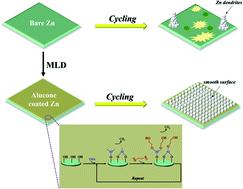当前位置:
X-MOL 学术
›
J. Mater. Chem. A
›
论文详情
Our official English website, www.x-mol.net, welcomes your
feedback! (Note: you will need to create a separate account there.)
Suppressing Zn dendrite growth by molecular layer deposition to enable long-life and deeply rechargeable aqueous Zn anodes
Journal of Materials Chemistry A ( IF 10.7 ) Pub Date : 2020-09-25 , DOI: 10.1039/d0ta07232j Huibing He 1, 2, 3, 4, 5 , Jian Liu 1, 2, 3, 4, 5
Journal of Materials Chemistry A ( IF 10.7 ) Pub Date : 2020-09-25 , DOI: 10.1039/d0ta07232j Huibing He 1, 2, 3, 4, 5 , Jian Liu 1, 2, 3, 4, 5
Affiliation

|
Rechargeable zinc-ion batteries (ZIBs) in mild/neutral aqueous electrolytes are promising for large-scale energy storage applications due to their merits of high capacity, intrinsic high safety, low cost and environmental benignity. However, the overall performance of ZIBs has been severely hindered by the uneven electrostripping/plating of Zn on the anodes, which could cause Zn dendrite formation, enlarged overpotential (capacity decay) and even cell short-circuit (inferior cycling stability). Herein, alucone, an inorganic–organic hybrid coating, by the molecular layer deposition (MLD) technique, was developed to address the aforementioned problems and improve the reversibility of Zn anodes for ZIBs. As a result, a long-life and deeply rechargeable Zn anode was demonstrated. With the optimized coating thickness of 60 MLD cycles (∼12 nm), an over 11-fold enhancement in the running lifetime (780 vs. 70 h) and a reduced overpotential (84.3 vs. 110.3 mV) were achieved compared to bare Zn at a current density of 3 mA cm−2. Besides, the rechargeability of the Zn anode at high current densities and deep stripping/plating levels was also improved by alucone coating. Furthermore, the alucone coated Zn has been verified in Zn/MnO2 batteries and consequently, superior electrochemical performance with a high capacity retention of 83.3% after over 800 cycles at a current density of 1C was demonstrated. The detailed structure, morphology and surface chemistry evolution of Zn metal were comprehensively studied for interpreting the improved electrochemical performance. It is expected that this work may pave the way towards to rational design of high-performance aqueous ZIBs and shed light on the development of other metal anode-based battery systems.
中文翻译:

通过分子层沉积抑制Zn树枝状晶体的生长,以实现长寿命且深度可充电的含水Zn阳极
中性/中性水性电解质中的可充电锌离子电池(ZIB)具有高容量,本质上的高安全性,低成本和对环境有益的优点,因此有望用于大规模储能应用。然而,阳极上不均匀的锌电剥镀/电镀会严重阻碍ZIB的整体性能,这可能会导致锌枝晶的形成,过大的电势(容量衰减)甚至电池短路(循环稳定性差)。本文中,通过分子层沉积(MLD)技术开发了一种无机-有机混合涂层糊精,以解决上述问题并改善ZIBs锌阳极的可逆性。结果,证明了长寿命且可深充电的Zn阳极。通过60个MLD周期(〜12 nm)的优化涂层厚度,与70小时)和减小的超电势(84.3对比110.3毫伏)分别实现比较以3mA cm 2的电流密度,以裸露的Zn -2。除此之外,通过糊精涂层还提高了锌阳极在高电流密度和深层剥离/电镀水平下的可充电性。此外,已在Zn / MnO 2中验证了用铝酮包被的Zn电池,因此,在电流密度为1C的情况下,经过800次循环后,具有优异的电化学性能和83.3%的高容量保持率。全面研究了锌金属的详细结构,形貌和表面化学演变,以解释改善的电化学性能。预计这项工作可能会为合理设计高性能水性ZIBs铺平道路,并为其他基于金属阳极的电池系统的开发提供启发。
更新日期:2020-10-12
中文翻译:

通过分子层沉积抑制Zn树枝状晶体的生长,以实现长寿命且深度可充电的含水Zn阳极
中性/中性水性电解质中的可充电锌离子电池(ZIB)具有高容量,本质上的高安全性,低成本和对环境有益的优点,因此有望用于大规模储能应用。然而,阳极上不均匀的锌电剥镀/电镀会严重阻碍ZIB的整体性能,这可能会导致锌枝晶的形成,过大的电势(容量衰减)甚至电池短路(循环稳定性差)。本文中,通过分子层沉积(MLD)技术开发了一种无机-有机混合涂层糊精,以解决上述问题并改善ZIBs锌阳极的可逆性。结果,证明了长寿命且可深充电的Zn阳极。通过60个MLD周期(〜12 nm)的优化涂层厚度,与70小时)和减小的超电势(84.3对比110.3毫伏)分别实现比较以3mA cm 2的电流密度,以裸露的Zn -2。除此之外,通过糊精涂层还提高了锌阳极在高电流密度和深层剥离/电镀水平下的可充电性。此外,已在Zn / MnO 2中验证了用铝酮包被的Zn电池,因此,在电流密度为1C的情况下,经过800次循环后,具有优异的电化学性能和83.3%的高容量保持率。全面研究了锌金属的详细结构,形貌和表面化学演变,以解释改善的电化学性能。预计这项工作可能会为合理设计高性能水性ZIBs铺平道路,并为其他基于金属阳极的电池系统的开发提供启发。































 京公网安备 11010802027423号
京公网安备 11010802027423号